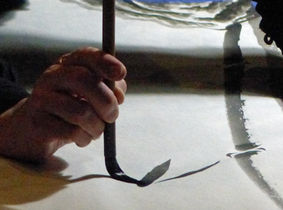

Birstall and District Art Society
Paul Maslowski
Chinese brushwork
Chengdu has a phenomenal art community, but it doesn’t get shared in the press. China is massive - larger than the whole of Europe. Landscapes vary vastly. Mandarin has unified language but there are still 56 languages spoken. China has 8000 years of history
Traditional painting is very hard but so rewarding when you get it right. Paul is giving a glimpse tonight but urges to go and see the work in the Ashmolean Request access to the postgraduate centre - this can be done online. The Japanese Fish School developed over 100 years but originated in China.
[ Link to Ashmolean search https://collections.ashmolean.org/collection/search/per_page/25/offset/0/sort_by/relevance/sort_order/asc/view_as/grid I searched for Chinese and Japanese Paintings which gave some interesting results which can be printed. – Bob W.]
Our member Sue Phipps has worked with Paul over the years and some might remember seeing her work.
The Pentel ink brush is worth trying. There are four elements in Chinese painting: paper, brushes, ink stones and ink. Paul urges us to only use ink that smells nice: it will be better quality. A perfume called dragon’s breath is used. The ink is ground on the stone - Artists will have assistants to do this and in the heat it evaporates very quickly. In our climate this doesn’t happen so quickly!
Paul is using pure black and a series of grey. Colour, if used, is the final step of a painting.
Before putting brush to paper, we saw Paul estimating where his lines would be on the paper. A rock was painted in the corner to which Paul added lines, then random ‘tails’, indicating shadow.
He then started to paint ‘a feeling’ of bamboo. Bamboo is linked to calligraphy, which is at the core of Chinese brushwork. Once drawn, you cannot go and fiddle. The trunk was followed by nodes. Paul pointed out how the slow marks by the nodes were darker and where the brush was faster you get what is known as ‘flying white’, which is patchier. Fine lines were added by each node.
A hurricane will flatten bamboo but the following day it will be upright again, which is symbolic to the Chinese. It is one of the ‘nobles’. There is a misconception that Chinese artists were male. Women were painters in China but rarely put their names to work.
Paul is using Xuan paper. This has a smooth side, which is painted on and a rough side. The paper used is very thin. There is also paper made from bamboo (called grass) and even paper made out of jeans! Japanese writing paper is the very best.
Brushes used by Paul are wolf hair which gives a good point and rabbit/goat hair, which holds more ink.
Paul said that if it goes wrong you learn how to deal with it, but unlike some other media, all strokes are committed.
Paul also showed us some calligraphy. He demonstrated a square, which translates as ‘mouth’. Following calligraphy rules, each stroke has to be different, so the end product appeared less square. The strokes also have to be in the right order. A long vertical line through the square changed the character to ‘China’. Paul also showed us 2023 Year in calligraphy and his name and ‘I painted this’.
Moving back to the original painting, Paul applied a wash, but as the original lines were allowed to dry, they remained. Every stroke should be seen. Unlike with many western methods where the painting gets darker, Chinese painting gets lighter. Moving to the leaves, Paul carefully constructed each with a single brushstroke, up then down. He explained that each leaf must go in a different direction. Groups of three leaves look like swifts. Having done two groups in black, Paul moved to grey ink, which initially looked as dark but will dry lighter. The aim is to practice until you can paint 10,000 shades of grey! Moving the brush around allows you to vary the stroke.
White spaces are left in Chinese paintings… ask yourself ‘Does this allow you to breathe’? Often there is a feeling of being crushed by paintings that have come from busy cities such as Shanghai.
After the break Paul, in his words, with a fresh page, ‘went bonkers’, quickly adding some heavy strokes and applied water over the top. These heavy downward strokes became mountains rising out of the mist. As the paper is thin the ink goes straight through. It is possible to paint on both sides, but due to the ‘size’ on the paper you get a different effect. To add pine trees Paul showed how little lines come down into a centre point to form a cup shape and multiples of these form a tree. This represents basalt columns with trees growing out of them that are near Shanghai.
It was fascinating to discover that there is a definite parallel between Tai Chi and techniques used in painting. Paul ably demonstrated some of these moves. Paul showed us a ‘goddess of mercy’ painting that bears a great similarity to the Virgin Mary, even having a halo.
Paul shared some of his more detailed work, showing the same techniques as he had demonstrated. He explained that when you stop, the ink spreads, so it is important to learn to control this.
At the end Paul shared how through recovering from a broken neck (he was told he would never walk again), he learned Tai Chi and, with advice, this progressed to painting. Paul knows when he is feeling in a good enough mood because he is able to paint with fine lines.
Meg Grant
~~~~~~~~~~~~~~~~~~~~~~~~~~~~~~~~~~~~~~~~~~~

































